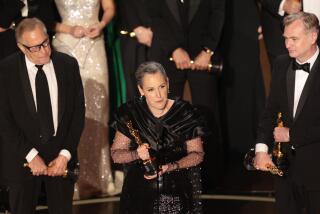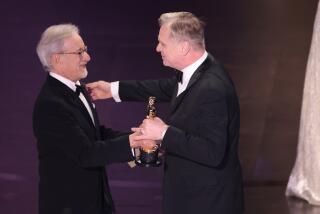‘SUNSHINE,’ WITH A FEW CLOUDS
- Share via
THE 7-year-old girl at the center of “Little Miss Sunshine” is nearly barred from the film’s namesake beauty contest. Fortunately for “Superfreak” fans everywhere, the young contestant does get out there and strut her stuff. But that moment in the limelight may be denied to some of “Little Miss Sunshine’s” producers, as they seek to compete in Hollywood’s ultimate pageant -- the Academy Awards.
Even though the five producers are a collegial bunch (in public at least), they may be torn apart by one of the most divisive Oscar rules.
To curb excessive producer credits, the Academy of Motion Picture Arts and Sciences limits the number of producers on best picture nominees to three. “Little Miss Sunshine” has five, all of whom had a hand in producing the movie.
“I think everyone played a role in making this film happen,” says Marc Turtletaub, who financed the film and is one of the five producers.
Although the film may never reach the best picture race, which rarely honors crowd-pleasing comedies, its long-shot odds steadily improve as more contenders fall by the wayside.
Before academy voters can cast their ballots, though, the Producers Guild of America must hold an arbitration to determine who properly deserves credit. . The PGA can award as many producer credits as it likes, but the academy insists the ultimate tally never exceed three, and will ask the PGA to trim the list if needed.
“It’s too bad that when your movie does well, these are the questions that emerge,” says producer Albert Berger, who with partner Ron Yerxa runs Bona Fide Productions, the first to get hold of Michael Arndt’s “Sunshine” screenplay.
That the movie has five producers dramatizes the intricacies of independent film production, where movies pass through any number of filmmaking hands. A review of the film’s path to the screen shows that all five performed critical tasks in pushing “Little Miss Sunshine” toward reality. Like so many movies, “Little Miss Sunshine” started with a relationship.
Arndt gave his script to Berger and Yerxa, whom he’d met on the set of 1999’s “Election,” in late 2001. After a number of rejections, the two producers brought the movie to Deep River Productions, a venture between Marc Turtletaub and David T. Friendly that had developed “Joe College” with Berger and Yerxa. “I started reading it at 1 a.m.,” Turtletaub says. “When I put it down, I said, ‘We’re going to make this.’ ” Deep River bought the script for $150,000. Berger and Yerxa next successfully pushed Jonathan Dayton and Valerie Faris, veteran music video and commercial directors who had never made a movie, to helm the film.
During the spring of 2002, Turtletaub, Friendly, Berger and Yerxa offered “Little Miss Sunshine” to DreamWorks, Artisan, Miramax and others, all without success. But USA Films was interested, and “Little Miss Sunshine” found a home.
That was both its blessing and curse. USA changed management and became Focus Features. The Focus business model is anchored by foreign pre-sales, which are largely driven by casting combinations, not scripts and directors. Over the course of three years and scores of meetings and conference calls, Deep River, Bona Fide and Focus kicked around various “Little Miss Sunshine” casting combinations -- Robin Williams, David Duchovny or Alec Baldwin for the movie’s motivational-speaker dad, Bill Murray for its suicidal uncle, Donald Sutherland for the foul-mouthed grandpa. Nothing ever jelled.
“It became clear to me that it wasn’t going to get made,” Turtletaub says. So Turtletaub, who had made a windfall with his lending business the Money Store, decided in late 2004 to finance the $7.5-million movie himself under his new company with producer Peter Saraf, Big Beach Films. “That way, I had only myself to please,” he says. Meanwhile, Friendly worked to persuade Greg Kinnear, who was nervous about the film’s concluding dance sequence, to star in the film as the dad. The rest of the cast -- Steve Carell, Adam Arkin, Toni Collette -- quickly fell into place.
Unlike some arms-length financiers, Turtletaub says he joined Saraf on the set every day of the film’s 30 days of production. Friendly, who was also producing “Big Momma’s House 2,” was there for eight. Berger and Yerxa, who had three other movies in production, were only occasional visitors to the set. Turtletaub and a sales agent negotiated the film’s record $10.5-million Sundance Film Festival sale to Fox Searchlight. “While each of the producers made a very real contribution to the film,” Friendly says, “we have to live by the decision of our guild.”
More to Read
Only good movies
Get the Indie Focus newsletter, Mark Olsen's weekly guide to the world of cinema.
You may occasionally receive promotional content from the Los Angeles Times.











